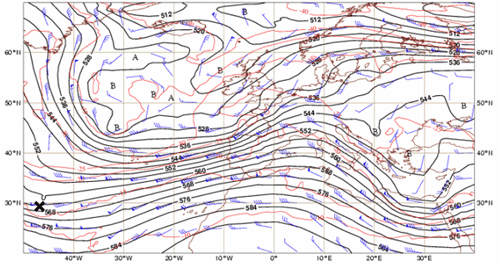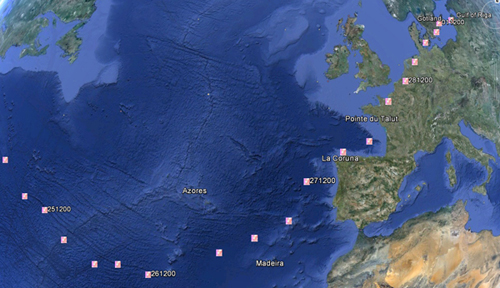The Storm
Xynthia had its genesis on 26th February and its life cycle lasted for eight days. Its genesis was related to an already existing low-pressure system that formed on 25th February east of Bermuda over a subtropical area of the North Atlantic (Figure 1.1.1).

This region was characterized by warm and moist air at low levels and an upper level wave embedded in the westerlies. Xynthia's path was quite unusual, crossing the Atlantic from subtropical latitudes towards Russia. In its early stage over subtropical latitudes, Xynthia showed organized deep convection that was quite well depicted by satellite imagery. Later Xynthia lost its convection activity, mainly after passing the west coast of Portugal (Figure 1.1.2).
Figure 1.1.2 - MSG Airmass RGB between 21:00 on 25/02/2010 and 00:00 UTC on 02/03/2010. This animation follows the centre of the storm during the whole trajectory.
Xynthia had an explosive development and a rapid displacement between the 26th and 28th, bringing a strong flow of warm air over all continental Europe until its end on 5 March. At the surface, Xynthia was mainly a complex low until its landfall in the early hours of the 28th on the French Atlantic coast. At the upper levels it was rather difficult to detect its related short-wave trough, which was embedded in a large-amplitude upper trough for most of its life cycle.
The severe storm was mainly a windstorm with reports of damaging winds from the Madeira Islands to northern Europe, with gusts exceeding 150 km/h (81 kt) in some regions. This large spatial coverage over the European territory was another distinctive aspect of Xynthia, as can be seen in Figure 1.1.3. There were also reports of large amounts of precipitation (both rain and snow) but these were not as unusual as the wind observations. In western Europe and mainly in France, Xynthia caused around 60 casualties, which resulted from drownings caused by severe storm surge events. Also, the storm caused significant damage and destruction, with trees being uprooted, roofs untiled and electrical grids being seriously affected, cutting off power in over a million households in France and Portugal. Total economic losses caused by Xynthia were estimated at € 3.6 billion in all the affected countries.
